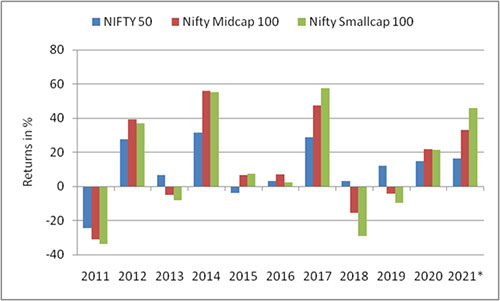Mid-cap and Small-cap Funds are on a Dream Run. Should You Invest?
Listen to Mid-cap and Small-cap Funds are on a Dream Run. Should You Invest?
00:00
00:00
Mid-cap funds and Small-cap funds have generated stellar returns since bulls took charge of the equity market towards the end of March 2020. Many mid-cap and small-cap stocks have spiralled upwards in the last one and a half years outpacing their large-cap peers. With this, mid cap and small cap indices have scaled new record highs.
The Nifty Smallcap 100 index reached an all-time high level of 10,617 on August 02, 2021. Meanwhile, the Nifty Midcap 100 index achieved this feat on August 03, 2021, scaling an all-time high of 28,266. Notably, this rally has come after a sharp underperformance between 2018 and 2019. During this period, the segment had faced several headwinds such as slowdown in economic growth and the liquidity crisis in NBFCs.
The revival in economic activities after the government gradually lifted lockdown restriction as well as the availability of vaccine for COVID-19 has uplifted investor sentiment. As mid-cap and small-cap stocks have a positive correlation with economic growth, the broader market has attracted the interest of investors once again.
Lakhs of new investors entered the equity markets after the deep market crash in March 2020, bolstered by hopes of recovery. As a result, active participation of retail investors in the mid-cap and small-cap segment drove the rise in mid-cap mutual funds and small-cap mutual funds.
 Image source: rawpixel.com - www.freepik.com
Image source: rawpixel.com - www.freepik.com
Here are some of the other factors driving the growth in mid-cap and small-cap segment:
1. Many Mid and small-sized companies undertook cost cutting measures to sail through pandemic-induced financial crisis. This helped them register strong growth in earnings during the financial year 2020-21.
2. The central bank's measures to support growth and infuse liquidity provided easy and low-cost access to capital.
3. The government announced various growth measures to boost manufacturing such as Production-linked incentives and emergency credit line guarantee scheme.
4. Mid-cap mutual funds and small-cap mutual funds benefitted from its higher exposure to stocks in Pharma and Infotech sector. On the other hand, lower allocation to stocks in the banking and finance sector enabled it to maintain a lead over large-cap peers.
Table: Mid-cap and Small-cap funds' terrific rally in the last one year
Data as on August 09, 2021
(Source: ACE MF, PersonalFN Research)
Will the dream run in mid-cap and small-cap space continue?
Due to the massive rally in the mid-cap and small-cap space, many stocks are now trading at expensive valuations. The mid-cap index and small-cap index has gained 33% and 46%, respectively on a year-to-date basis. Since last year's low, the mid-cap index has recovered 152%, while the small-cap index has recovered 206%.
This implies that the margin of safety has narrowed. Even though the market could continue to rally for some more time, it is important to tread with caution.
When you invest in smaller companies, remember that for every high-potential stock, there is a long list of stocks that can turn out to be wealth destroyers. This is especially true for small-cap stocks. During a market rally even low-quality names that lack fundamentals begin to soar. Therefore, if the liquidity dries up mid-cap and small-cap segment could feel the impact first.
As the pandemic situation improves, the operating cost for companies is likely to increase. It is important that corporates maintain earnings growth on a sustainable basis when input cost increases, otherwise the markets might come under severe pressure.
Also, consumer confidence needs to strengthen if corporates want a consistent earnings show. At present, people are currently spending less with essentials showing signs of moderation. The non-essential spending continues to contract. After having witnessed the dreadful second wave, people are now fearing the ensuing waves of COVID-19. Hence, they are focusing on conserving cash or investing in wealth-producing investment avenues.
How to approach mid-cap funds and small-cap funds now?
Historical data suggests that no particular market cap can be an outperformer every year. Hence, diversification across market cap viz. large-cap, mid-cap, and small-cap is necessary. This will help lower the impact of volatility on your portfolio and thereby earn better risk-adjusted returns.
Mid-cap funds and small-cap funds have the potential to outpace large-cap funds over the long term. However, since mid-cap funds and small-cap funds are high-risk high-return avenues invest only if your risk profile permits it. Keep in mind that the segment can plunge lower than large-caps, if investor sentiments turn negative.
Graph: Mid-caps and small-caps outpace large-caps in the long run
 *YTD as on August 09, 2021
*YTD as on August 09, 2021
(Source: ACE MF, PersonalFN Research)
Given that the market volatility could intensify in the near future, avoid investing in mid-cap funds and small-cap funds with a short term view. Invest only if you have a long term investment horizon of at least 5-7 years.
Devise a strategy and take exposure sensibly depending on your risk profile and financial goals. If the financial goal for which you have invested is nearing, you can trim exposure to mid-cap fund and small-cap fund. Gradually shift exposure to less risky and stable categories such as large-cap funds and subsequently to safely managed debt mutual funds and/or bank deposits, etc.
Investors with a moderate risk profile looking to take meaningful exposure in mid-cap and small-cap segment can consider investing in Multi-cap funds, Flexi-cap funds, or Large & Midcap funds. These funds invest across market cap and are less risky than pure Mid-cap funds and pure Small-cap funds.
More importantly, invest only in those mid-cap funds and small-cap funds that focus on picking quality stocks in the mid-cap and small-cap segment. Avoid relying excessively on a fund's past performance; a top performing scheme of the past year may not be the top performer in the following year.
Watch this short video on selecting the best mutual fund schemes:
The important factor when selecting any scheme is to evaluate the consistency of a fund's performance based on quantitative and qualitative parameters. Finally, when you invest prefer the SIP mode to reduce the impact of volatility and benefit from the power of compounding.
Happy Investing!
PS: If you are looking for quality mutual fund schemes (including Equity-linked Saving Schemes) to add to your investment portfolio, I suggest you subscribe to PersonalFN's premium research service, FundSelect. PersonalFN's FundSelect service provides insightful and practical guidance on which mutual fund schemes to Buy, Hold, and Sell.
Currently, with the subscription to FundSelect, you could also get Free Bonus access to PersonalFN's Debt Fund recommendation service DebtSelect.
If you are serious about investing in a rewarding mutual fund scheme, subscribe now!
Warm Regards,
Divya Grover
Research Analyst
Join Now: PersonalFN is now on Telegram. Join FREE Today to get ‘Daily Wealth Letter’ and Exclusive Updates on Mutual Funds